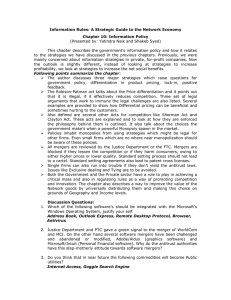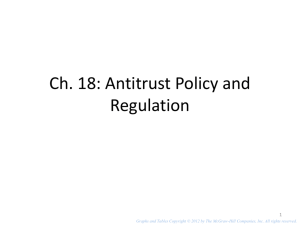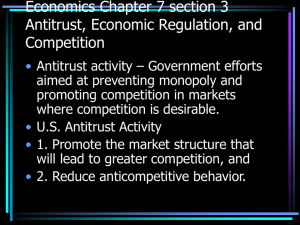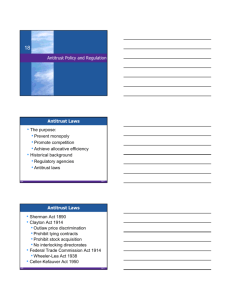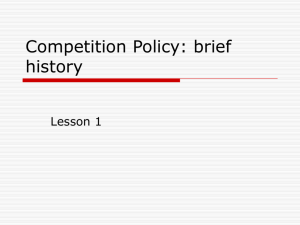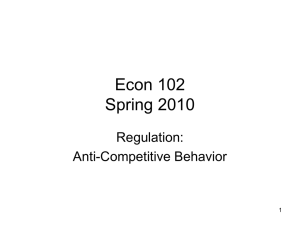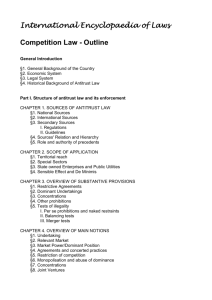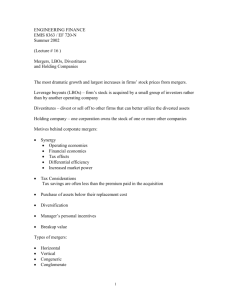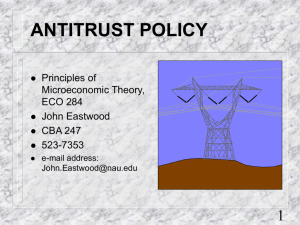Chapter 29 - Weber State University
advertisement
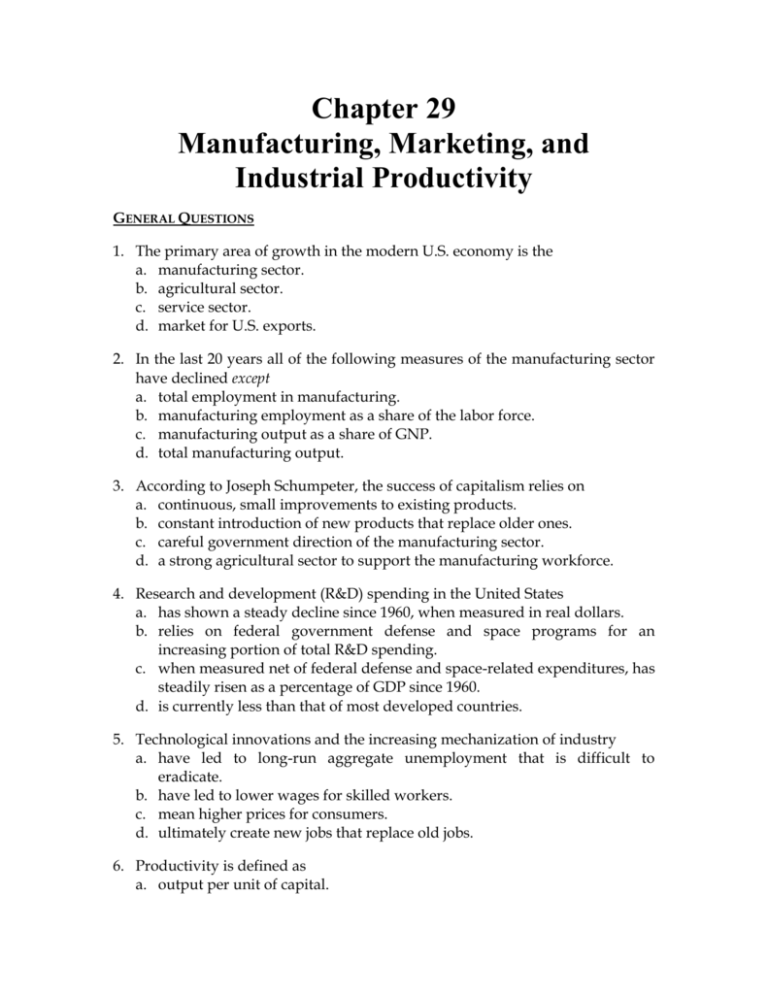
Chapter 29 Manufacturing, Marketing, and Industrial Productivity GENERAL QUESTIONS 1. The primary area of growth in the modern U.S. economy is the a. manufacturing sector. b. agricultural sector. c. service sector. d. market for U.S. exports. 2. In the last 20 years all of the following measures of the manufacturing sector have declined except a. total employment in manufacturing. b. manufacturing employment as a share of the labor force. c. manufacturing output as a share of GNP. d. total manufacturing output. 3. According to Joseph Schumpeter, the success of capitalism relies on a. continuous, small improvements to existing products. b. constant introduction of new products that replace older ones. c. careful government direction of the manufacturing sector. d. a strong agricultural sector to support the manufacturing workforce. 4. Research and development (R&D) spending in the United States a. has shown a steady decline since 1960, when measured in real dollars. b. relies on federal government defense and space programs for an increasing portion of total R&D spending. c. when measured net of federal defense and space-related expenditures, has steadily risen as a percentage of GDP since 1960. d. is currently less than that of most developed countries. 5. Technological innovations and the increasing mechanization of industry a. have led to long-run aggregate unemployment that is difficult to eradicate. b. have led to lower wages for skilled workers. c. mean higher prices for consumers. d. ultimately create new jobs that replace old jobs. 6. Productivity is defined as a. output per unit of capital. b. output per labor hour. c. output divided by the price level. d. the percentage change in total annual output. 7. Explanations for the decline in U.S. productivity in the 1970s and 1980s include all of the following except a. difficulties with measuring service sector output. b. the entry into the labor force of many young, inexperienced workers. c. a wave of corporate mergers that reduced competition. d. rising oil prices. 8. In the 1920s, mergers in the steel, cement, petroleum, and motion picture industries resulted in a. monopoly control of these industries. b. oligopoly markets in these industries. c. monopolistically competitive markets in these industries. d. lower profits in these industries. 9. A conglomerate merger is a combination of firms that a. formerly competed with each other. b. formerly bought from and sold to each other. c. produce nearly identical products, but are based in different countries. d. produce unrelated products or services. 10. Ling-Temco-Voight (LTV) is an example of a a. conglomerate. b. vertical merger. c. horizontal merger. d. limited-liability partnership. 11. The period from 1977 through 1989 saw a wave of corporate mergers in the United States. These mergers were characterized by a. the use of junk bonds for financing buyouts. b. the low debt-to-equity ratios of the resulting firms. c. resulting firms that focused on “core competencies” rather than diversification. d. a “buyers’ market” in which acquiring firms could purchase the stock of takeover targets for less than market value. e. all of the above. 12. Junk bonds are securities with a. low risk and low yield. b. high risk and high yield. c. low risk and high yield. d. high risk and low yield. 13. In 1991, AT&T acquired NCR in a $7.5 billion takeover. As a result of this merger, a. costs at NCR fell and profits rose. b. federal prosecutors brought antitrust charges against AT&T. c. NCR successfully entered the personal computer industry. d. long-term customers deserted NCR. e. all of the above 14. From the late 1930s until the early 1970s, courts tended to follow per se rules when deciding antitrust cases. According to these rules, a. a firm’s control of a large market share was considered intrinsically illegal. b. the existence of only one or two firms in an industry was not necessarily an antitrust violation. c. both market share and predatory practices must be considered in determining whether a firm had violated the law. d. the court should only intervene if the firm charged “unfair” prices. 15. In both U.S. v. E. I. Du Pont de Nemours and Company (1953) and Brown Shoe Company v. U.S. (1962), the Supreme Court’s decision depended heavily upon a. evidence of predatory practices in the firm’s early growth period. b. the definition of the relevant market for the firm’s product. c. evidence of “unfair” prices charged to consumers. d. the existence of collusive agreements between the firm and its competitors. 16. The decision in Federal Trade Commission v. Procter and Gamble Co. (1967) is considered an anomaly because in the 1960s antitrust cases involving ______________ were unusual. a. firms in the consumer products industry b. vertical mergers c. horizontal mergers d. conglomerate mergers 17. In the mid-1970s, antitrust policy began a new phase characterized by a. the use of per se rules. b. reliance on economic analysis. c. the definition of a monopoly as a firm with dominant market share. d. repeal of the Clayton Act. 18. In the 1970s, members of the Law and Economics program at the University of Chicago argued that a. per se rules should be adopted by the Supreme Court and used to decide antitrust cases. b. large firms should always be broken up in order to encourage competition. c. large market shares may be due to efficient management or innovation. d. courts should “get out of the antitrust business.” 19. U.S v. American Telephone and Telegraph Company was launched in 1974 and finally decided in 1984. Which of the following statements presents accurate information about this landmark case? a. Long distance phone rates have increased since the case was decided. b. The Department of Justice’s decision to pursue the case against AT&T rested in part on the entrance of MCI into the long-distance market. c. The Supreme Court’s decision in the case did not substantially change the market for telephone services. d. The Supreme Court’s decision permanently barred AT&T from entering any new communications or data-processing markets. 20. The major trend in wholesaling over the past 75 years has been a. the growth of full-line, full-service wholesale houses. b. a general decline in the use of wholesalers, with retailers increasingly dealing directly with producers. c. domination of the wholesale industry by about four major firms that serve the entire retail industry. d. the increasing importance of specialty wholesalers known as “short line” distributors. ECONOMIC INSIGHTS 1. The term “path dependence” refers to a. inefficient outcomes that result from early technology choices that are not optimal in the long run. b. the tendency for competitive markets to become monopolistic in the long run. c. inefficient outcomes that result from negative externalities. d. the natural growth of monopoly when economies of scale exist in a market. 2. Paul David examined ____________ as an example of path dependence. a. Microsoft’s Windows operating system b. the VHS format c. the QWERTY keyboard d. hydroelectric power generators ECONOMIC ANALYSIS 1. The introduction of computer-based technologies in the telephone industry caused a(n) a. increase in the supply of telephone services. b. increase in the demand for telephone services. c. increase in the price of telephone services. d. decrease in the number of calls handled daily by telephone companies. 2. An increase in the price of oil causes a(n) a. decrease in the demand for substitute goods. b. increase in the price of substitute goods. c. increase in the demand for complementary goods. d. increase in the price of complementary goods. 3. Measured in BTUs per dollar of real GDP, energy consumption fell by only 5 percent between 1970 and 1975, but had fallen by almost 30 percent by 1990. These figures illustrate the fact that energy demand a. does not respond to price changes in the short run. b. does not respond to price changes in the long run. c. is more elastic in the short run than in the long run. d. is more elastic in the long run than in the short run. Return to Economics 1740 Announcement/Practice Exam Page
